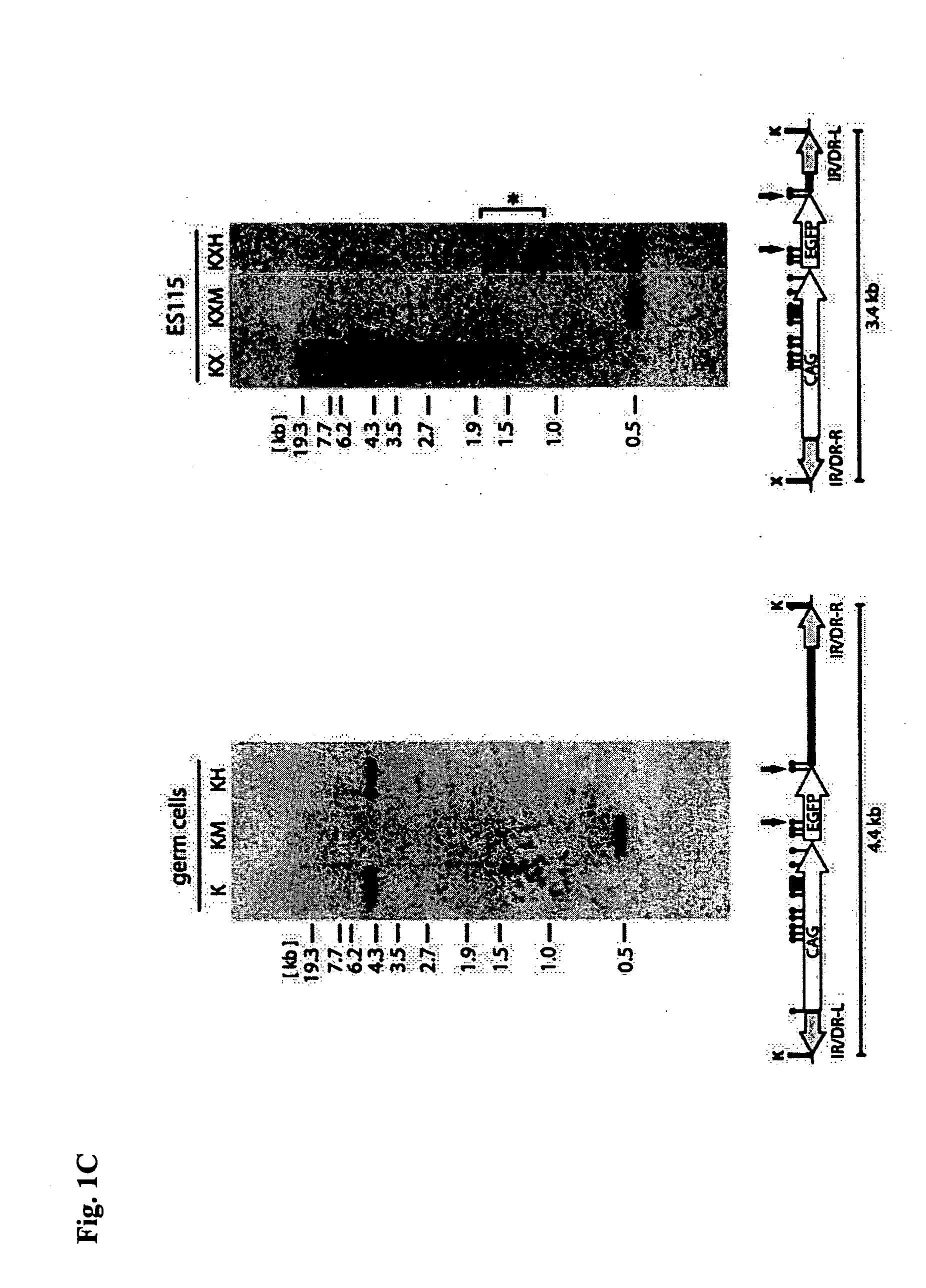Method of preparing transgenic organism with use of methylation and system therefor
- Summary
- Abstract
- Description
- Claims
- Application Information
AI Technical Summary
Benefits of technology
Problems solved by technology
Method used
Image
Examples
example 1
Transient Transposon Excision Assay)
[0351] First, the present Example confirmed whether methylation of a sequence encoding a transposon enhances excision capability.
[0352] (Transient Transposon Excision Assay)
[0353] Transposon DNA (pTransCX-EGFP: neo, Horie et al., PNAS 2001, Proc. Natl. Acad. Sci. USA.; 98:9191-6) has been methylated in advance with SssI CpG methylase (New England Biolabs; 50 mM NaCl, 10 mM Tris-HCl, pH7.9, 10 mM MgCl2, 1 mM DTT, 160 μM SAM, 0.2 U / μl SssI). Methylation has been verified by observing non digestion of the sample by methylation sensitive NotI.
[0354] Next, Murine erythroleukemia cell MEL cell; J. Mol. Biol. 292: 779-785, 1999) was introduced with transposon DNA and Sleeping Beauty (SB) transposase (PCMV-SB, obtained from Dr. P. Hackett). Total DNA was extracted from the cell using DNeasy Tissue Ki (QIAGEN), and PCR was conducted with the plasmid vector using primers (TgTP-1U, TgTP-2L (previously shown)) and 358 bp PCR product is detected, which is ...
example 2
Establishment of a Cell Having Methylated or Unmethylated Transposon in the Same Genetic Locus of a Murine Genome
[0366] Next, the present Example verifies whether methylation at the cellular level has an effect on transposition activity.
[0367] (Methods)
[0368] Two loxP sequences in reversed direction were constructed in a plasmid vector with a transposon located therebetween, and SssI CpG methylase was subjected thereto for methylation of the sequence encoding a transposon. Next, the plasmid DNA and the Cre recombinant enzyme expression vector were introduced to a MEL cell (strains RL5, RL6, E. E. Bouhassira, J. Mol. Biol. 292:779-785,1999) with hygromycin resistant gene and herpes viral thymidine kinase (HSVTK) as foreign genes (transgene) between the loxP sequence in reversed direction. The Cre recombinant enzyme allows recombination between the plasmid and the loxP on the genome, resulting in the establishment of a cell having a transposon in a specific site on the genome. This...
example 3
Effects of DNA Methylation in the Same Site in the Murine Genome on a Transposon Excision Reaction
[0379] The cell line established in Example 2, was introduced with SB transposase (PCMV-SB, available from P. Hackett, U. of Minnesota), and genomic DNA was recovered 48 hours thereafter. The collection of the genome was conducted using a genome extraction kit (DNeasy Tissue Kit, QIAGEN). Nested PCR was used for detecting the excision of a transposon. Ten rounds of PCR reactions were conducted per cell line. One μg of genomic DNA was used as a template for reaction in the 1st PCR. The primers used are shown as follows:
[0380] 1-1) TgTP-1U (SEQ ID NO: 6)
[0381] 1-2) TgTP-2L (SEQ ID NO: 7)
[0382] 2-1) TgTP-2U (TCTATCGCCTTCTTGACGAGTTCTTCTGAG; SEQ ID NO: 8)(2nd PCR; nested PCR)
[0383] 2-2) TgTP-3L (CAAGCGCGCAATTAACCCTCACTAAAGG; SEQ ID NO: 9)(2nd PCR; nested PCR)
[0384] The thus obtained sample (1 μg) was used as a template for the nested PCR for the following experiments. The genomic DNA o...
PUM
| Property | Measurement | Unit |
|---|---|---|
| Fraction | aaaaa | aaaaa |
| Biological properties | aaaaa | aaaaa |
| Nucleic acid sequence | aaaaa | aaaaa |
Abstract
Description
Claims
Application Information
 Login to View More
Login to View More - R&D
- Intellectual Property
- Life Sciences
- Materials
- Tech Scout
- Unparalleled Data Quality
- Higher Quality Content
- 60% Fewer Hallucinations
Browse by: Latest US Patents, China's latest patents, Technical Efficacy Thesaurus, Application Domain, Technology Topic, Popular Technical Reports.
© 2025 PatSnap. All rights reserved.Legal|Privacy policy|Modern Slavery Act Transparency Statement|Sitemap|About US| Contact US: help@patsnap.com



